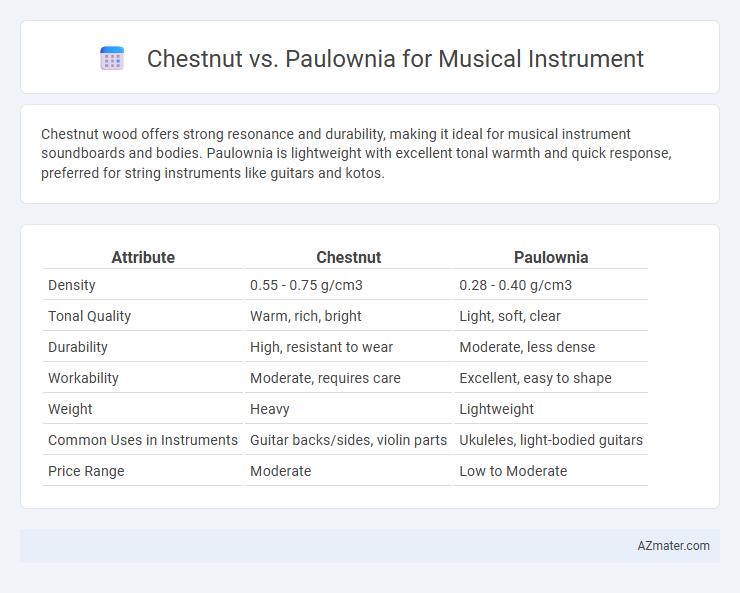Chestnut wood offers strong resonance and durability, making it ideal for musical instrument soundboards and bodies. Paulownia is lightweight with excellent tonal warmth and quick response, preferred for string instruments like guitars and kotos.
Table of Comparison
| Attribute | Chestnut | Paulownia |
|---|---|---|
| Density | 0.55 - 0.75 g/cm3 | 0.28 - 0.40 g/cm3 |
| Tonal Quality | Warm, rich, bright | Light, soft, clear |
| Durability | High, resistant to wear | Moderate, less dense |
| Workability | Moderate, requires care | Excellent, easy to shape |
| Weight | Heavy | Lightweight |
| Common Uses in Instruments | Guitar backs/sides, violin parts | Ukuleles, light-bodied guitars |
| Price Range | Moderate | Low to Moderate |
Introduction to Chestnut and Paulownia Woods
Chestnut wood, valued for its durability and warm tonal qualities, is commonly used in traditional string instruments, offering a rich resonance and natural sustain. Paulownia wood is lightweight and exhibits a fine, straight grain that produces bright, clear sound characteristics, making it popular in modern experimental luthier designs. Both woods bring distinct acoustic properties suited for different musical instrument applications, with chestnut favoring depth and warmth, while paulownia excels in lightness and clarity.
Historical Use in Musical Instrument Making
Chestnut wood has been historically favored for constructing traditional string instruments due to its durability and warm tonal qualities, commonly seen in European craftsmanship from the Renaissance period onward. Paulownia wood, renowned for its lightweight and resonant properties, has a long-standing role in East Asian musical instrument making, particularly in the production of kotos and other zithers. The contrasting historical use of chestnut and paulownia highlights regional preferences in wood selection driven by acoustic performance and material availability.
Physical Properties: Density and Weight
Chestnut wood typically has a density ranging from 0.55 to 0.70 g/cm3, making it moderately heavy and offering a solid, resonant tone well-suited for musical instruments requiring stability and warmth. Paulownia, with a lower density of approximately 0.28 to 0.40 g/cm3, is significantly lighter, which provides excellent resonance and easier handling for portable instruments. The lighter weight of Paulownia enhances sound projection and reduces player fatigue, while Chestnut's higher density contributes to durability and a richer tonal quality.
Acoustic Characteristics and Tone Quality
Chestnut wood offers a warm, rich tone with strong midrange projection and natural resonance, making it ideal for acoustic guitars and violins that require robust sound qualities. Paulownia is lightweight with a bright, clear, and balanced tonal profile, favored in instruments such as ukuleles and classical guitars for its quick response and enhanced sustain. The density and grain structure of chestnut contribute to deeper bass frequencies, while paulownia's porous texture emphasizes articulate highs and crisp note definition.
Workability and Crafting Ease
Chestnut offers excellent workability with its moderate density and straight grain, making it easier to carve and shape for detailed musical instrument components. Paulownia is lightweight and soft, allowing for quick crafting and effortless hand-tool use, ideal for instruments requiring resonance and reduced weight. Both woods support precise tuning and finishing, but chestnut typically provides greater durability while paulownia excels in fast, easy processing.
Durability and Longevity in Instruments
Chestnut wood offers superior durability and longevity for musical instruments due to its dense, hard grain structure, which resists wear and environmental changes effectively. Paulownia, while lightweight and resonant, is softer and less resistant to dents and moisture, making it more susceptible to damage over time. Instruments crafted from chestnut typically maintain tonal quality and structural integrity longer than those made from paulownia, supporting extended use and better investment value.
Environmental Impact and Sustainability
Paulownia wood is highly regarded for its rapid growth rate and carbon sequestration capabilities, making it an environmentally sustainable choice for musical instruments compared to the slower-growing chestnut. Chestnut, while durable and offering rich tonal qualities, often entails more significant environmental impacts due to longer harvest cycles and susceptibility to blight, which can reduce sustainable yields. The low density and fast regeneration of paulownia contribute to less deforestation and a reduced carbon footprint in instrument manufacturing.
Cost and Availability Comparison
Chestnut wood is generally more affordable and widely available compared to Paulownia, making it a cost-effective choice for musical instrument manufacturing. Paulownia, prized for its lightweight and resonant properties, tends to be more expensive due to its limited supply and slower growth cycle. The availability of Chestnut in larger quantities supports consistent production, whereas Paulownia's scarcity can lead to higher prices and limited sourcing options.
Popular Instruments Made from Chestnut vs Paulownia
Chestnut is commonly used for crafting guitar backs and sides, prized for its warm tonal qualities and attractive grain patterns that enhance acoustic resonance. Paulownia is favored in traditional Asian instruments such as kotos and shamisen, valued for its lightweight and resonant properties that produce clear, expressive sounds. Both woods serve distinct roles in instrument making, with chestnut lending durability and rich tonal depth while paulownia offers a lighter build and bright, airy tones.
Choosing the Right Wood for Musical Instruments
Chestnut offers a warm tone with rich midrange frequencies, making it ideal for acoustic guitars and violins that require balanced sound projection. Paulownia wood provides a lightweight structure and bright, clear resonance, favored in instruments where ease of play and sharp tonal clarity are priorities. Selecting the right wood hinges on the desired sound characteristics, instrument weight, and durability, with chestnut emphasizing tonal warmth and paulownia enhancing responsiveness and brightness.

Infographic: Chestnut vs Paulownia for Musical Instrument
 azmater.com
azmater.com